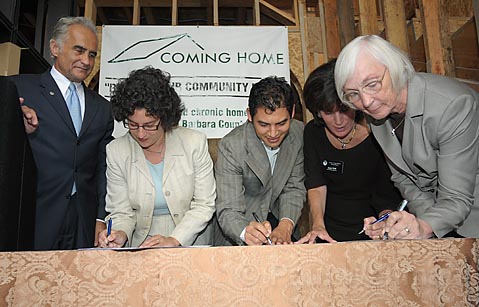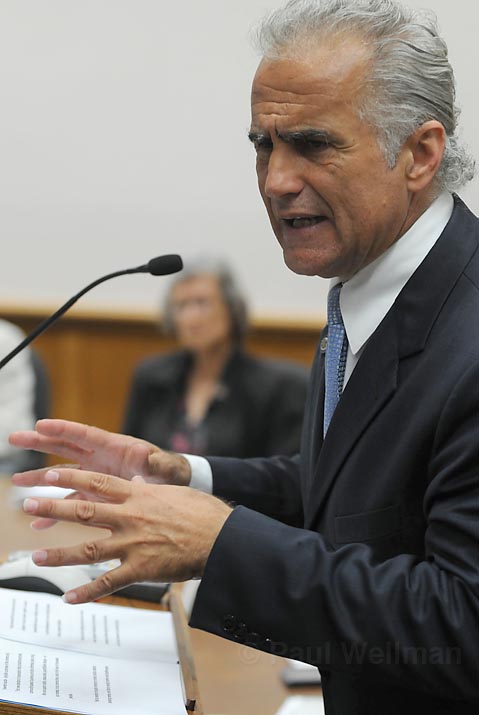Federal Homeless Official Tours Santa Barbara Housing
Seasonal Shelters Relics of Failure, Permanent Housing gthe Ticket, Says Mangano

The federal government’s top homeless official delivered what could best be described as a lively and sophisticated hour-long sermon to government officials, media, and service providers during his four-hour tour of Santa Barbara on Thursday, July 10. Philip Mangano, executive director of the U.S. Interagency Council on Homelessness, is on a multi-city tour of the US touting permanent housing as the solution to homelessness that will relegate it to the dustbin of history.
The days of “managing and servicing homelessness” are over, according to Mangano. He warned against nostalgia for well-intended approaches that merely maintain the condition of homelessness, such as seasonal shelters. He quipped that one day visitors will be able to visit the “Shelter Museum of Santa Barbara to see what homelessness once was” just as they now visit the Underground Railroad Museum to remember slavery. “Our homeless neighbors have a longing for home,” said Mangano, “and a fear that they won’t get home. That is the only nostalgia we need to be concerned with.”

The cost to permanently house the chronically homeless is small compared to the cost to police, prosecute jail, medicate, provide emergency services for, and otherwise maintain the same population on the streets, Mangano said. Studies recently completed in 65 cities and counties around the nation calculated that on average, a chronically homeless person on the streets costs taxpayers between $35,000 and $150,000 annually. To provide stable housing costs $13,000 to $25,000, he said, which includes mental health and other support services
“You don’t have to be Warren Buffet,” Mangano said, to decide which strategy yields a better return.
He insisted that the segment of the population needing, in effect, free housing is “finite,” and “an anomaly.” In Santa Barbara County, the tally of chronically homeless people was just under 1000 in a 2006 report on homelessness services-and they consumed more than $18 million in services and assistance, according to the report’s author, former Director of County Health Roger Heroux.
Countering the widespread perception that those who are chronically homeless prefer life on the streets, Mangano said, is the countervailing evidence that “when offered a key to an apartment, homeless people come in.” Plenty of examples to support that premise were on display during Mangano’s tour of permanent housing projects recently completed in the City of Santa Barbara including the two-year-old El Carrillo, whose 61 studios, 256 square feet each, with no parking, are housed in an architecturally beautiful Spanish-style courtyard complex. Several residents whose doors were ajar-either to keep their rooms cool or in anticipation of the tour-invited Mangano and entourage into lovingly decorated rooms and answered his questions.
One of the middle-aged men Mangano talked to had camped for a year on the grounds of a church. Two others had lived for many years in their cars. One of these, Peter Panza, who has a Bachelor’s degree in industrial engineering, was once flippantly dubbed “the scariest man in Isla Vista” by the Daily Nexus, UCSB’s student-run daily paper, which subsequently issued an apology when a sympathetic shopkeeper came to Panzer’s defense. While homeless, Panzer cost the court system a certain amount of money fighting tickets for illegal camping and parking, with the assistance of the Committee for Social Justice. He said he has lived at El Carrillo since it opened and appreciates that it is civil and safe.
A younger woman named Sandy Graff said that she had never lived on the streets but had stayed off and on at Sanctuary Psychiatric Center, Phoenix House, and the county’s emergency Psychiatric Health Facility due to bipolar symptoms. She now works for pay one day a week stocking shelves at Long’s. On other days she works as a volunteer, handling a peer-support line for the county’s Crisis and Recovery Emergency Services, and escorting visitors and pushing wheelchairs at Cottage Hospital.
“Rob Pearson is great,” Mangano said later, of the City of Santa Barbara’s Housing Authority director, who conceived and nurtured El Carrillo. “He gets this issue, and has devoted so much time and energy to creating this kind of housing.”
Places like El Carrillo do not keep everybody off the street. Veronica Loza, the housing authority’s director of housing management, estimated that there were six evictions in the first year of El Carrillo’s operation, and that now there is one about every three months. Nor is the need for emergency services entirely eliminated: There were 40 police calls the first year, she estimated, and 10 so far this year.
Mangano also talked with residents of Casas Las Granadas, the dozen apartments gracing the outside of the Granada parking structure across the street from the library, built by People’s Self-Help Housing earlier this year, also housing the formerly homeless. And he toured Building Hope, the new edifice under construction at 617 Garden Street, which will provide 51 affordable apartments, 38 of them reserved for clients of the Mental Health Association. It is scheduled for completion before the end of the year, said MHA boardmember George Kaufmann. It stands to lose more than a third of its funding, in the form of tax credits, if it is not. Besides that $10 million, Building Hope’s $28 million cost is being funded $5 million from the City of Santa Barbara, $5.2 million from the MHA’s capital campaign and reserves, and a mortgage from the Santa Barbara Bank and Trust.



